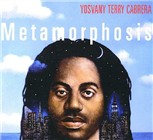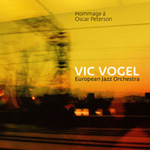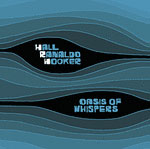Home » Jazz Articles » Interview » Yosvany Terry: Growth from Tradition
Yosvany Terry: Growth from Tradition
I wake up everyday trying to learn more about the tradition in order to grow as a musician
 Saxophonist, composer, arranger Yosvany Terry received his early musical training from his father, Eladio "Don Pancho Terry. He is a graduate of the National School of Art and Amadeo Roldan Conservatory in Cuba. He has performed with Chucho Valdes, Sylvio Rodriguez, Jesus Alemany y Cubanismo, Jane Bunnett and the Spirits of Havana, Dafnis Pietro, Avishai Cohen, the International Vamp Band, Eric Revis, Steve Coleman, Los Terry and Columna B.
Saxophonist, composer, arranger Yosvany Terry received his early musical training from his father, Eladio "Don Pancho Terry. He is a graduate of the National School of Art and Amadeo Roldan Conservatory in Cuba. He has performed with Chucho Valdes, Sylvio Rodriguez, Jesus Alemany y Cubanismo, Jane Bunnett and the Spirits of Havana, Dafnis Pietro, Avishai Cohen, the International Vamp Band, Eric Revis, Steve Coleman, Los Terry and Columna B. Since his arrival in New York in 1999, Terry has been absorbing American jazz traditions and combining them with his Afro-Cuban roots to produce compositions and solo work that flow from "sweet sounding lyricism to wild-eyed avant-garde. He is part of a new generation of musicians who is redefining the way jazz is perceived. Metamorphosis (Kindred Spirits Records) is Yosvany Terry's first album as a leader.
All About Jazz: Congratulations on Metamorphosis, your debut recording as a leader. The title refers to your ongoing journey as a musician...
Yosvany Terry: Yes. The title represents the transformation I experienced when I moved to New York [from Cuba]. It also refers to the vast amount of information that suddenly became available to me from so many cultures. New York is such a special city and there are so many things happening. I wanted [the title] to capture the spirit and the moment.
AAJ: Did you compose all of the material?
YT: Yes, all but one tune. "The Crying was composed by my brother, Yunior. The interesting thing is that I recorded an album that most people [in the states] don't know about. It was recorded in Spain on a small record label.
AAJ: You wouldn't be referring to Colomna B, would you?
YT: Yes, En Clave! All the tunes were composed by members of the band. It's not like I started composing when I moved here. I was already composing when I was in school [in Cuba]. At that time there was a whole new generation of musicians, many of whom are now living in different countries. We were part of that moment that was happening in Cuba. The music I am composing and performing now is an extension of that. The difference between now and then is the exposure to other cultures.
AAJ: While we are on the subject of Colomna B, is there any possibility that the band might reunite someday?
YT: Right now we don't have any intentions of doing that. What I mean is, we are not thinking about it, but that does not mean it can't happen.
AAJ: Some time ago I witnessed a Colomna B reunion, of sorts. The event took place at [New York's] Babacu. It was the closing party for the Havana Film Festival. You performed with [pianist] Roberto Caracals and [drummer] Dafnis Prieto. The missing link was the original bassist but John Benitez filled in beautifully. Maraca Valle and his band also performed that evening.
YT: Yes, John Benitez sat in on bass.
AAJ: You started out playing the violin [at a very early age], then switched to the saxophone. Why the switch?
YT: I started out playing the violin when I was five years old but when I went to school I ran into some problems. In Cuba students generally start school at the age of five or six. I started when I was seven. Because of the system [in Cuba] they wouldn't allow me to attend school. My father urged me not to get frustrated and suggested that I switch to another instrument. At the time there was an ad on TV that had an influence on me. It featured the saxophonist from Araucaria. Even though I started out playing classical music I always wanted to play popular music.
AAJ: Much like your father, Don Pancho Terry, you are a master Cachoeira player. Was your father your main influence?
YT: My father recently celebrated fifty years in the music business. He also plays the violin. Yes, definitely, my father is my main influence.
 AAJ: Metamorphosis is a retrospective of the people, places, events and things that you have encountered from the beginning of your career to present day. Could you recount some of the more significant people, places or events that brought you to where you are today?
AAJ: Metamorphosis is a retrospective of the people, places, events and things that you have encountered from the beginning of your career to present day. Could you recount some of the more significant people, places or events that brought you to where you are today?
YT: There are quite a few. One of those special moments was when I moved to Havana from Cambegei. There, I was exposed to people from all over the country, which was well because I started getting together with the best musicians in school and formed a band. Another great thing that happened to me was getting together with the guys from Colomna B. It was great because it was an opportunity to experiment. We were four different characters and each one of us brought something interesting to the table. It helped us grow as musicians. We experimented with a lot of different concepts.
The other thing that happened to me was when I started working with Silvio Rodriguez. I toured with him when I was 22 or 23 years old. It opened my eyes to the music of Latin America. I played with Silvio for about a year and half. Then I started playing with [pianist] Carlos Masa and I was exposed to Europe. It was an incredible opportunity to experience the European festivals, etc.
AAJ: Let's go through Metamorphosis, track by track. The Okonkolo provides a stable rhythmic pattern that allows the parent drums [the Iya and Itotelo] to converse. You use the rhythmic patterns of the Okonkolo as the foundation for "Okonkolo Concertante. Is this part of a concerto?
YT: The idea was to write a concerto featuring the Okonkolo, the smallest of the three bata drums.
AAJ: "El Burlón (the Joker) speaks to the idea of maintaining a sense of humor in one's art. In your liner notes, you mention that the rhythmic-harmonic motif reminds you of a buffoon. How so?
YT: Yes, by the pattern that I wrote for the piano. It was the first motif I conceived. It doesn't stay with the same character all the time.
AAJ: On "Journey of Awareness, you are joined by percussionist/vocalist Pedro Martinez. The piece is dedicated to the West African deity Obatala. It speaks to discovering new harmonic sounds and concepts. What is your method for discovering new sounds and concepts?
YT: My creative process comes from my research and the processes that most musicians go through. If you wake up every day and you only play standards from the Great American Song Book you will get better, but you have to experiment and try different things, hear different music, research different cultures. Because of my African heritage, I have always been attracted to the richness of the African legacy. In Cuba there are things that have been kept that no longer exist in Africa. That is something that inspires me and makes me want to learn more.
AAJ: "The Crying [composed by brother, Yunior Terry] has a cinematic, melancholy quality. What was Yunior alluding to when he composed this tune?
YT: Yunior wrote that at a time when it was said that all communication between Cuba and the U.S. was going to be terminated. He wrote it thinking that he might never speak to his [our] parents again. That's why it has a...I don't know the word, a...
AAJ: Melancholy?
YT: Yes, a melancholy sound.
 AAJ: "Subversive is all about New York City. The vibe, the diversity. Why did you choose the word, subversive?
AAJ: "Subversive is all about New York City. The vibe, the diversity. Why did you choose the word, subversive?
YT: New York has a subversive attitude. There is so much happening in the underground that never pops up. However, if you live here you learn about all the great, creative things that are happening that are not part of the mainstream. To me that is the most important part of New York. I am speaking about the kind of creative things that inspire musicians like me . . .
AAJ: Tell me about "Transito and how you envisioned [musically] a traffic jam.
YT: Yes, it's about the feeling of a traffic jam in Havana or New York. Cuba and New York have a lot in common. There is always something happening!
AAJ: "Rampa Abajo La Rampa is the name of the street that leads to El Malecon in Havana. Did composing this tune bring back any special memories from your childhood?
YT: I composed the tune in Cuba and never used it. I revived it for Metamorphosis, although I didn't decide to use it until the day before the recording session. This is another tune that talks about the vibe in New York and Havana, but it talks about it in a different way.
AAJ: It has been said that you and musicians such as Miguel Zenon, Luis Perdomo and Dafnis Prieto represent a new generation of Latin American artists whose vibrant, contemporary sounds are shaking up the jazz world. How do you see it?
AAJ: In my case, I don't do things consciously, thinking I want to change something. Nobody does that consciously. I don't think Thelonious Monk was doing what he did consciously. I wake up everyday trying to learn more about the tradition in order to grow as a musician. I wake up in the morning saying, I want to learn more about Coleman Hawkins, Sonny Rollins, Irakere, Miguelito Cuni. I believe that is the same thing Luis and Dafnis are doing. We still marvel over old recordings and play them for one another. At the same time I stay in tune with what is happening now. There are musicians all over the world—Cuba, Brazil, Asia and South America—that are doing interesting things.
AAJ: But when you do something in New York it seems to have a larger impact.
YT: New York is a different country!
AAJ: In my opinion, there are two cities that qualify as different countries: New York and New Orleans.
YT: I had the same feeling the first time I went to New Orleans. I saw the commonality between Cuba, New Orleans and the old culture.
AAJ: When will Metamorphosis be released?
YT: Tentatively, March 10th [2006].
AAJ: And what is the name of the record label?
YT: It is on the Kindred Rhythm label [in the U.S.]
AAJ: And the CD release party will be at The Jazz Gallery, on March 10th and 11th?
YT: Yes.
AAJ: I couldn't think of a more appropriate venue. The Jazz Gallery is where you began your career.
YT: That was back in 2000 or 2001. I spoke to [founder] Dale Fitzgerald about performing with my band and the timing was right. I performed with my band every Thursday and invited guests such as trumpet players Brian Lynch and Roy Hargrove and others. About four or five months into the series I suggested that we bring in other bands and start a series. That evolved into the Jazz Cubano series. That's when artists such as Dafnis Prieto and [bassist] John Benitez came on the scene. At the time, not too many people were familiar with The Jazz Gallery.
 AAJ: I remember the Jazz Cubano series well! What's up next for Yosvany Terry?
AAJ: I remember the Jazz Cubano series well! What's up next for Yosvany Terry?
YT: Well, I am planning a tour to promote the album. We are planning to play in Vermont and on the West Coast. We will be doing some different things.
AAJ: What, or who were you listening to, just prior to coming here this evening?
YT: Earlier today I was listening to Miles with Wayne Shorter, Herbie Hancock and Ron Carter. But it varies from day to day. Yesterday I was listening to Coleman Hawkins and Los Munequitos de Matanzas. My brother and I also listen to the popular groups in Cuba like Los Van Van and Irakere. My brother was recently in West Africa and he brought back a whole lot of music.
AAJ: Yosvany, it has been a pleasure speaking with you. Good luck with your new recording. I will see you at the CD Release party!
Selected Discography:
Yosvany Terry Septet, Metamorphosis (EWE Records, 2006)
Dafnis Prieto, About the Monks (Zoho Music, 2005)
Avishai Cohen, At Home (Razdaz Records, 2005)
Eric Rives, Tells of the Stuttering Mime (11:11 Records, 2004)
El Negro and Robby, Third & Four World War: Live in Perugia (EWE Records, 2004)
Avishai Cohen, Lyla (Razdaz, 2004)
The International Vamp Band, Unity (Concord Records, 2001)
Yosvany Terry Quintet, Twisted Noon (Bombo Music Production, 2000)
Columna B, En Clave (Mas Y Mas, 1998)
Steve Coleman & The Mystic Rhythm Society, The Sign and the Seal (BMG, 1997)
Steve Coleman & The Mystic Rhythm Society, Genesis (BMG, 1997)
Jane Bunnett, Chamalongo (Blue Note, 1997)
Marilyn Lerner, Uptown Irawo (Tonga Records, 1997)
Marilyn Lerner, Birds are Returning (Jazz Focus Records, 1997)
Gema y Pavel, Cosa de Broma (Nube Negra, 1996)
Jesus Alema y Cubanismo, Malembe (Hannibal, 1996)
Jesus Alema y Cubanismo, Cajon Song (Hannibal, 1996)
Photo Credit: Martin Cohen
Tags
PREVIOUS / NEXT
Support All About Jazz
 All About Jazz has been a pillar of jazz since 1995, championing it as an art form and, more importantly, supporting the musicians who make it. Our enduring commitment has made "AAJ" one of the most culturally important websites of its kind, read by hundreds of thousands of fans, musicians and industry figures every month.
All About Jazz has been a pillar of jazz since 1995, championing it as an art form and, more importantly, supporting the musicians who make it. Our enduring commitment has made "AAJ" one of the most culturally important websites of its kind, read by hundreds of thousands of fans, musicians and industry figures every month.






















